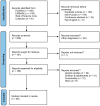Alterations in Neurotrophins in Alcohol-Addicted Patients during Alcohol Withdrawal
- PMID: 38928583
- PMCID: PMC11202159
- DOI: 10.3390/brainsci14060583
Alterations in Neurotrophins in Alcohol-Addicted Patients during Alcohol Withdrawal
Abstract
Background: Alcohol use disorder (AUD) is related to mental and somatic disorders that result in alcohol withdrawal syndrome (AWS), with 30% of AWS cases leading to life-threatening delirium tremens (DTs). Currently, studies do not support using any one biomarker in DTs. Neurotrophins affect neuromodulation, playing a role in the pathogenesis of AUD, AWS, and DTs.
Methods: This review aims to summarize experimental and clinical data related to neurotrophins and S100B in neuroplasticity, as well as neurodegeneration in the context of AUD, AWS, and DTs. This work used publications that were selected based on the protocol consistent with the Preferred Reporting Items for Systematic Reviews and Meta-Analysis (PRISMA) statement.
Results: The BDNF level could be a good candidate biomarker for relapse susceptibility, as it is significantly reduced during consumption and gradually increases during abstinence. GDNF influences AUD through its integral role in the function of dopaminergic neurons and ablates the return to alcohol-drinking behavior. NGF protects neurons from ethanol-induced cytotoxic damage and affects recovery from cognitive deficits after brain damage. The NT-3 level is decreased after alcohol exposure and is involved in compensatory mechanisms for cognitive decline in AUD. NT-4 affects oxidative stress, which is associated with chronic alcohol consumption. S100B is used as a biomarker of brain damage, with elevated levels in serum in AUD, and can protect 5-HT neurons from the damage caused by alcohol.
Conclusions: BDNF, GDNF, NT-3, NT-4, NGF, and S100B may be valuable markers for withdrawal syndrome. In particular, the most relevant is their association with the development of delirium complications. However, there are few data concerning some neurotrophins in AWS and DTs, suggesting the need for further research.
Keywords: alcohol use disorder; alcohol withdrawal syndrome; delirium tremens; neurotrophic factors.
Conflict of interest statement
The authors declare no conflicts of interest.
Figures


Similar articles
-
The "Prediction of Alcohol Withdrawal Severity Scale" (PAWSS): systematic literature review and pilot study of a new scale for the prediction of complicated alcohol withdrawal syndrome.Alcohol. 2014 Jun;48(4):375-90. doi: 10.1016/j.alcohol.2014.01.004. Epub 2014 Feb 19. Alcohol. 2014. PMID: 24657098 Review.
-
Quantitative electroencephalographic analysis of delirium tremens development following alcohol-withdrawal seizure based on a small number of male cases.Brain Behav. 2022 Dec;12(12):e2804. doi: 10.1002/brb3.2804. Epub 2022 Oct 28. Brain Behav. 2022. PMID: 36306397 Free PMC article.
-
Diagnosis and treatment of acute alcohol intoxication and alcohol withdrawal syndrome: position paper of the Italian Society on Alcohol.Intern Emerg Med. 2019 Jan;14(1):143-160. doi: 10.1007/s11739-018-1933-8. Epub 2018 Sep 5. Intern Emerg Med. 2019. PMID: 30187438
-
The effect of alcohol withdrawal syndrome severity on sleep, brain and cognition.Brain Commun. 2020 Aug 14;2(2):fcaa123. doi: 10.1093/braincomms/fcaa123. eCollection 2020. Brain Commun. 2020. PMID: 33543128 Free PMC article.
-
Perioperative Management of Alcohol Withdrawal Syndrome.Visc Med. 2020 Jun;36(3):160-166. doi: 10.1159/000507595. Epub 2020 Jun 9. Visc Med. 2020. PMID: 32775345 Free PMC article. Review.
References
-
- Zgliczyński W. Alkohol w Polsce (Alcohol in Poland) INFOS. 2016;11:1–4.
Publication types
Grants and funding
LinkOut - more resources
Full Text Sources
Research Materials
Miscellaneous

